This OB speaker is in the planning stage albeit I already have the mid range drivers. The mid / tweeter section will look like this:

The 16 mid range drivers are 2.5” BMRs which I intend to use over c. 200hz to c. 3500hz. The central tweeter is a ribbon. Although I have shown space between the drivers, in practice they will be edge to edge and joined together and suspended by paracord so as to be baffle-less.
I have heard some box speakers that used a somewhat similar array of full range drivers (albeit just used for mids) and subjectively the array sounded like a single wide dispersion source. However, what I’m struggling to get my head around is what the dipole distance will be for such an array and therefore what the dipole peak will be.
I’d welcome the thoughts of those on this forum who have taken a deep dive into dipole behaviour.
The 16 mid range drivers are 2.5” BMRs which I intend to use over c. 200hz to c. 3500hz. The central tweeter is a ribbon. Although I have shown space between the drivers, in practice they will be edge to edge and joined together and suspended by paracord so as to be baffle-less.
I have heard some box speakers that used a somewhat similar array of full range drivers (albeit just used for mids) and subjectively the array sounded like a single wide dispersion source. However, what I’m struggling to get my head around is what the dipole distance will be for such an array and therefore what the dipole peak will be.
I’d welcome the thoughts of those on this forum who have taken a deep dive into dipole behaviour.
Hi, I would expect the mid array behave much like a similar sized single driver on same baffle. This is because sound emits at any point on a transducer. This array is more flat compared to big cone, and less surface area (Sd), but distribution of where sound emits is very similar. Let's do quick VituixCAD sim, wait a second.
edit. here results from simplified ideal simulation. Bit more differences than I thought, so it's interesting.
My array pattern is not exactly the same. For fun with three different size small transducerrs, and then the big one rouhgly similar in total size. Baffle in both cases is off same size.
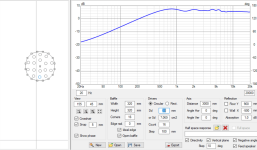
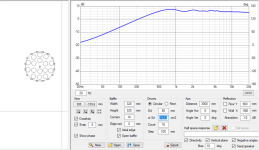
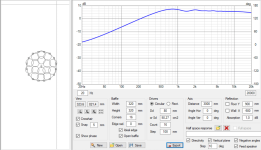
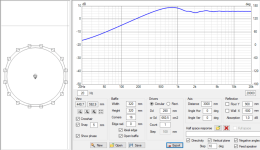
Here one of the arrays and the single big one in the main window:
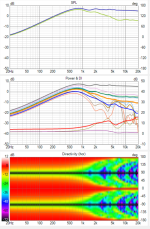
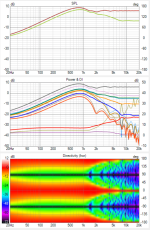
Pattern seems to be wider with the array, not sure why is that whether it's artifact of the simulator or due to distribution of the sources, likely due to distrtibution of the sources. Main diffraction hump / dipole peak is less pronounced as well. Perhaps it's because there is no source at exact center, on-axis SPL seems to be less with the array.
In reality differences are even more between array and single similar sized driver I think, backsides of the BMR are very different than backside of single big driver, for example.
edit. here results from simplified ideal simulation. Bit more differences than I thought, so it's interesting.
My array pattern is not exactly the same. For fun with three different size small transducerrs, and then the big one rouhgly similar in total size. Baffle in both cases is off same size.




Here one of the arrays and the single big one in the main window:


Pattern seems to be wider with the array, not sure why is that whether it's artifact of the simulator or due to distribution of the sources, likely due to distrtibution of the sources. Main diffraction hump / dipole peak is less pronounced as well. Perhaps it's because there is no source at exact center, on-axis SPL seems to be less with the array.
In reality differences are even more between array and single similar sized driver I think, backsides of the BMR are very different than backside of single big driver, for example.
Last edited:
wasn't due to no sources in the center, here simulation with sources in the center and the response is like the array above. Not sure why there is more power with array than single driver, also less axial response, perhaps it's just due to less Sd distributed over bigger baffle area. Here roughly the same sim with 18 drivers.
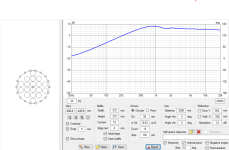
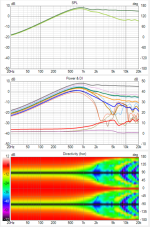
While the response has some differences, the dipole peak is roughly at same frequency as with single big driver, below 1000Hz. If you run system like this to 3500Hz and crossover to very wide response ribbon, you get quite a kink in DI and it's not ideal in that sense, you'd better cross closer to 1000Hz according to these sims. You could shrink the mid array to smaller for bit higher xo.
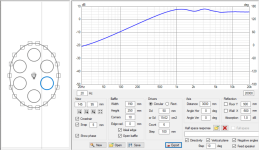



While the response has some differences, the dipole peak is roughly at same frequency as with single big driver, below 1000Hz. If you run system like this to 3500Hz and crossover to very wide response ribbon, you get quite a kink in DI and it's not ideal in that sense, you'd better cross closer to 1000Hz according to these sims. You could shrink the mid array to smaller for bit higher xo.


Last edited:
With array still dipole peak is at about 1 kHz and first minimum is at 2 kHz, what makes problematic to use array in range 200-3500 Hz. Range can be pushed down with DSP if driver have long Xmax or expected SPL is low. Range extension to higher than 2 kHz is only possible with smaller baffle, but then also rang lower point goes higher.
Pattern seems to be wider with the array, not sure why is that whether it's artifact of the simulator or due to distribution of the sources, likely due to distrtibution of the sources. Main diffraction hump / dipole peak is less pronounced as well. Perhaps it's because there is no source at exact center, on-axis SPL seems to be less with the array.
In reality differences are even more between array and single similar sized driver I think, backsides of the BMR are very different than backside of single big driver, for example.
In my experience, a worse pattern always happens when/if you try to mimic one large source/driver with a number of smaller ones having about the same footprint.
@tmuikku Good point about the rear radiation. This is something that a "model" will not capture. You have to buy the driver and measure what is happening to the rear, which is important if you really want a dipole source. Sometimes the driver has a peaky resonance back there, and that will eventually reach the listener via the room...